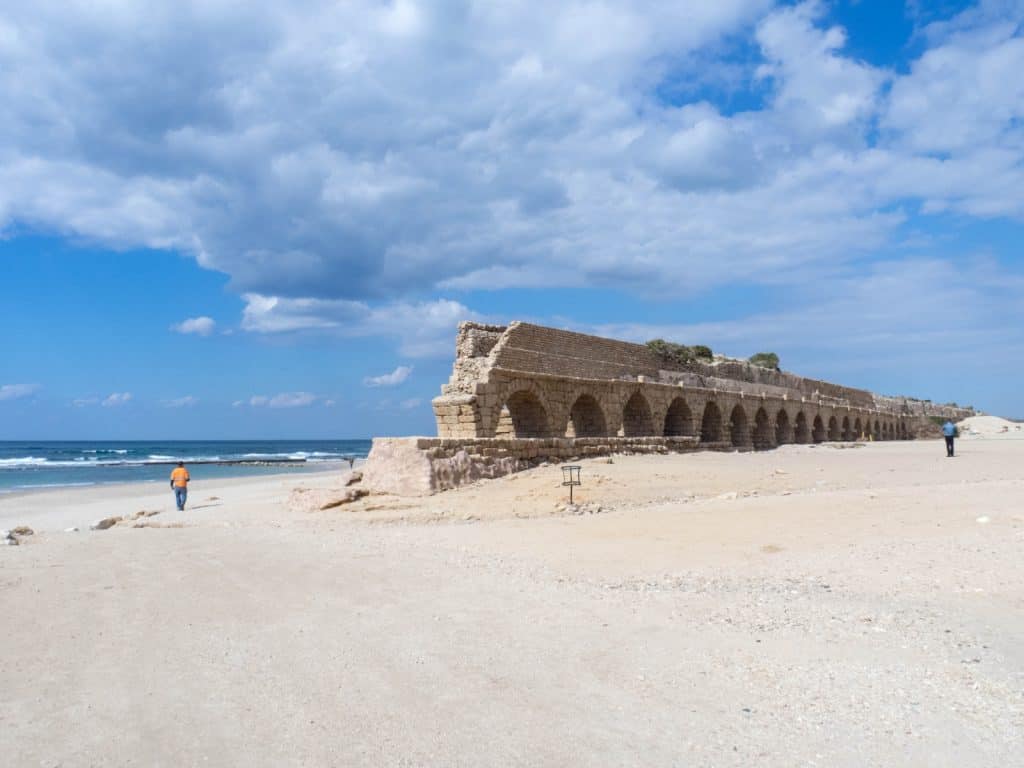I visited Caesarea (also: Qeisarya) on my last day in Israel because of the following quote and discovered one of my favorite historical sights in the country: an aqueduct on the beach.
“He chose for himself a lost city on the sea shore, named ‘Straton’s Tower’, because it had beautiful scenery and was worthy of respect.”
Yosef Ben Matityahu aks Josephus Flavius in “The wars of the Jews”
I start my journey in Akko. After visiting the Rosh Hanikra grottoes at the Israel-Lebanon border the day before, I have spent the night in the old Knights’ city.
My stomach full with the usual lush HI Israel buffet breakfast, I walk over to the train station and jump on the next train South. For an hour we follow the coast before we turn inland. Unfortunately, it is my stop. The nearest train station to Caesarea is Binyamina, 6km from the sea and the national park. I leave the train station and find the bus stop on its western side. Bus number 9 would take me to my destination. But it isn’t due for a while. So I start walking instead.
1.5 hours later, I pass a random pillar in a field, a sure sign, I am getting close to the old city.
I have reached the ruins in a rather inconvenient spot. The crusader fort entrance sits between two famous sights. So I turn left first and walk towards the Roman amphitheater. I pass the remains of temples and the port, the Hippodrome (or Herodian amphitheater), which has partly been taken over by the massive bath complex, and the remains of what once must have been a grand palace in the sea. All that’s left of the palace is the outline of a rectangular pool that once formed the courtyard of the palace.
The ground is littered with shards of clay pots and marble. You know that a place is rife with histories of past lives when they are too many shards for anyone to bother to collect them and reassemble the item they fell from.
The Roman amphitheater is not quite as impressive as other examples because it is more a modern construction than a reconstruction. But I like the background of endless sea and sit down to enjoy my lunch sandwich.
Then, I turn back and walk along the beach until I reach the beginning the aqueduct, which running along the sea, was once used to transport freshwater from Shuni springs and Crocodile River in the North. This surprising and surprisingly well-preserved site has to continuously be reclaimed from the fine white sand of the beach, which makes it look even more impressive.
After only two hours of exploration, I walk back to Route 2. It is Friday, and I want to catch the bus to Tel-Aviv from Or Akiva Junction before Shabbat begins.
Practical info about Caesarea & links
- Getting to Caesarea by public transport:
- From Tel-Aviv, the easiest route is taking buses #826 or 910 from the Tel-Aviv Central Bus Station to Or Akiva Interchange and walk 1.5 km to the National Park.
- You can also take the train to Binyamina and then change into Kavim bus #9 to Caesarea Antiques Center. Click here for the current bus #9 schedule.
- Click here for the official Caesarea website by the Israel Parks authority.
- Seeing Caesarea sites for free:
- Caesarea National Park does not include the aqueduct. So if you only want to see that (plus some other ruins scattered outside the walls of the old city), you can do so for free. The beach along the aqueduct is also a great spot for spending a relaxing (summer) day. Buses 9, 76 and 80 stop at Rothschild St/HaRimon, about 500m from Aqueduct Beach.
- The ancient port with numerous restaurants and even a diving center can also be visited without a ticket. Simply enter from Israel National Trail in the North, circumventing the walls of crusader fort.

